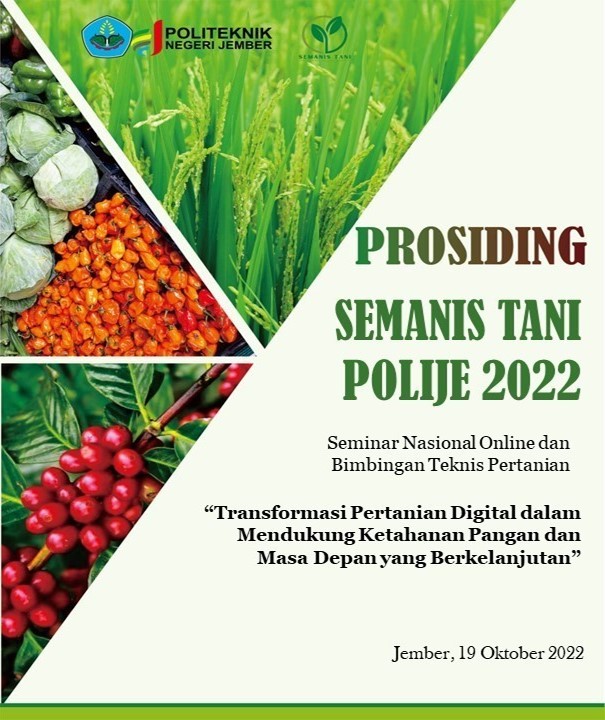Pertumbuhan dan Produksi Kangkung Hidroponik Sistem DFT pada Media Semai dan Jumlah Bibit yang Berbeda Growth and Production of Water Spinach Hydroponics DFT Sistem on Seedling Media and Different Number of Seeds
DOI:
https://doi.org/10.25047/agropross.2022.274Kata Kunci:
Seeds, Hydroponics, Water spinach, Seedling, MediaAbstrak
Water spinach can be grown hydroponically using the DFT system. Seeding is needed before the seeds are transplanted, so it is necessary to select the appropriate seedling media because it will determine the initial growth of water spinach. The number of seeds per netpot also needs to be regulated because it affects the competition for growing space, nutrient absorption and sunlight reception. The purpose of this study was to determine the effect of seedling media and the number of seeds per netpot on the growth and production of water spinach in the DFT hydroponic system. The experiment was carried out in the Balitsa Lembang screen house from March to April 2022. The experiment used a two-factor randomized design with 3 replications. The first factor of seedling media consisted of: soil + cow manure, soil + sheep manure, and soil + subur ijo organic fertilizer. The second factor is the number of seeds per netpot consisting of: 6, 8, and 10 seeds. The results showed that the soil seedling media + sheep manure produced the highest seedling growth rate of 76.67%. 6 seedlings per netpot yielded the highest percentage of live plants, which was 96%. 6 seedlings per netpot resulted in higher plant height, stem diameter, plant weight, and harvest index than 10 seedlings, but not significantly different from 8 seedlings. Soil seedling media + sheep manure and 6 seeds per netpot can be used in DFT hydroponic cultivation of water spinach to increase production and save plant seeds.
Unduhan
Referensi
Ali, M., Hosir, A., & Nurlina, N. (2017). Perbedaan Jumlah Bibit Per Lubang Tanam terhadap Pertumbuhan dan Hasil Tanaman Padi (Oryza sativa L.) dengan Menggunakan Metode The System Rice Intensification. Gontor AGROTECH Science Journal, 3(1), 1. https://doi.org/10.21111/agrotech.v3i1.898
Amiroh, A., Nazam, A. U., & Suharso, S. (2019). Kajian Pengaruh Jumlah Bibit Per Lubang dan Jarak Tanam terhadap Pertumbuhan dan Produksi Padi. Agroradix, 3(1), 9–19. https://doi.org/10.52166/agroteknologi.v3i1.1706
Andayani, & La, S. (2013). Uji empat jenis pupuk kandang terhadap pertumbuhan dan hasil tanaman cabai keriting (Capsicum annum l.). Jurnal Agrifor, 12(1), 22–29.
Asmamaw, B. A. (2017). Effect of Planting Density on Growth, Yield and Yield Attributes of Rice (Oryza sativa L.). African Journal of Agricultural Research, 12(35), 2713–2721. https://doi.org/10.5897/ajar2014.9455
Febriyono, R., Susilo, Y. E., & Suprapto, A. (2017). Peningkatan Hasil Tanaman Kangkung Darat (Ipomoea reptans, L.) melalui Perlakuan Jarak Tanam dan Jumlah Tanaman per Lubang. Jurnal Ilmu Pertanian Tropika Dan Subtropika, 2(1), 22–27. http://jurnal.untidar.ac.id/index.php/vigor/article/view/323/257
Hadiyanti, N. (2018). Uji Pengaruh Jumlah Bibit Per Lubang Tanam terhadap Pertumbuhan dan Hasil Pasi (Oryza sativa L.) DI Green House. Agrinika, 2(2), 127–134.
Muyassir. (2012). Efek Jarak Tanam , Umur Dan Jumlah Bibit Terhadap Hasil Padi Sawah (Oryza sativa L.). Jurnal Manajemen Sumberdaya Lahan, 1(2), 207–212.
Nainggolan, I. M., Wijana, G., & Santosa, I. G. N. (2017). Pengaruh Jumlah Bibit dan Pupuk Organik terhadap Pertumbuhan dan Hasil Tanaman Padi (Oryza sativa L.). Jurnal Agroekoteknologi Tropika, 6(3), 319–328.
Pedrosa. (2014). Kandungan Gizi dan Manfaat Kangkung. https://manfaatnyasehat.blogspot.com/2014/01/kandungan-gizi-dan-manfaat-kangkung.html
Robiansah, H., Trisnaningsih, U., & Budirokhman, D. (2017). Pengaruh Kombinasi Takaran Pupuk Kandang dan Jarak Tanam terhadap Pertumbuhan dan Hasil Tanaman Kangkung Darat (Ipomoea reptans). Jurnal Agrijati, 31(1), 18–26.
Sari, K. R., Battong, U., & Sukiman, A. (2020). Pengaruh Umur Pemindahan Serta Jumlah Bibit pada Pertumbuhan dan Hasil Tanaman Padi (Oriza sativa L.). AGROVITAL : Jurnal Ilmu Pertanian, 5(1), 30. https://doi.org/10.35329/agrovital.v5i1.636
Setiawan, S., Abdurrahman, T., Magister, M., & Fakultas, A. (2020). Pengaruh Jumlah dan Umur Bibit terhadap Pertumbuhan dan Hasil Padi pada Lahan Sawah Tadah Hujan. Jurnal Agrifor, 19(1), 33–44. https://doi.org/https://dx.doi.org/10.31293/af.v19i1.4376
Shoumi, E. R., Soelistyono, R., Ninuk, D., Jurusan, H., Pertanian, B., & Pertanian, F. (2018). Pengaruh Media Tanam pada Vertikultur terhadap Pertumbuhan dan Hasil Tanaman Kangkung (Ipomoea reptans. Poir). Jurnal Produksi Tanaman, 6(2), 203–209.
Susilo, J., Ardian, & Ariani, E. (2015). Pengaruh Jumlah Bibit Per Lubang Tanam dan Dosis Pupuk N, P dan K terhadap Pertumbuhan dan Produksi Padi Sawah (Oryza sativa L.) dengan Metode SRI. Jom Faperta, 2(1), 1–15.
Zulkifli, Z., & Herman, H. (2012). Respon Jagung Manis (Zea mays saccharata Stut ) terhadap Dosis dan Jenis Pupuk Org
Unduhan
Diterbitkan
Cara Mengutip
Terbitan
Bagian
Lisensi
Hak Cipta (c) 2022 Ika Cartika, Hamdan Drian Adiwijaya

Artikel ini berlisensi Creative Commons Attribution 4.0 International License.
Hak cipta (Copyright) artikel yang dipublikasikan di Agropross : National Conference Proceedings of Agriculture dipegang oleh penulis (Copyright by Authors) di bawah Creative Commons Attribution 4.0 International License (CC-BY). Sehingga penulis tidak memerlukan perjanjian pengalihan hak cipta yang harus diserahkan kepada redaksi.






